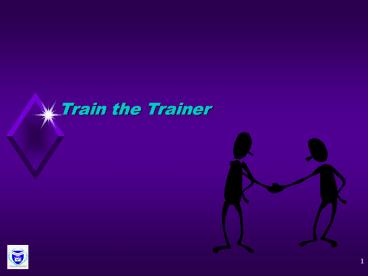Train the Trainer PowerPoint PPT Presentation
Title: Train the Trainer
1
Train the Trainer
2
Host Facilitator
- Be prepared
- Be available
3
We Absorb or Retain
(same report as previous slide)
- 10 of what we read
- 20 of what we hear
- 30 of what we see
- 50 of what we see and hear
- 70 of what we say
- 90 of what we say as we act
4
We learn
- 1 through taste
- 1.5 through touch
- 3.5 through smell
- 11 through hearing
- 83 through sight
5
Chinese Proverbs
- I hear and I forget
- I see and I remember
- I do and I understand
- A picture is worth a thousand words
6
Bob Pikes laws of learning
- People dont argue with their own data
7
Bob Pikes laws of learning
- Learning is directly proportional to the amount
of fun you have
8
Bob Pikes laws of learning
- Learning has not taken place until behavior has
changed
Arkansasnese If it aint caught, it aint taught
9
- Three Person Teaching
- Covey
- Triple Transfer of Training
- Pike
10
90/20/8
- Adults will sit for 90 minutes
- But will retain only 20 minutes of information
- We are conditioned to 8 minute spans of
information
11
People Learn in Different Ways
- Personal Learning Insights Profile
12
Learning Purpose
- Why you want to learn something
- Practical
- Prefers to learn material that relates to what
you already know, and want to know how you can
use it - Informative
- Prefers new and interesting information, whether
its practical or not - Practical/Informative
- May learn both, depending upon the situation
13
Learning Structure
- How you structure information, how you want it
presented - Specific
- Prefer information to be presented in a specific,
organized, highly structured manner - General
- Prefer information to be presented in a very
general way, you make you own structure - Specific/General
- Your preference for presentation varies
14
Learning Activity
- How active you want the learning process to be
- Participative
- You like to be actively involved in the learning
process - Reflective
- You like to think about the information you take
- Participative/Reflective
- Comfortable with both
15
People Learn in Different Ways
- Brain Dominance
16
Whole Brain Model
Cerebral Mode Thinking Process
Upper Left
Upper Right
Holistic Intuitive Integrating Synthesizing
Logical Analytical Fact Based Quantitative
Right Mode Thinking Process
Left Mode Thinking Process
Organized Sequential Planned Detailed
Interpersonal Feeling based Kinesthetic Emotional
Lower Left
Lower Right
Limbic Mode Thinking Process
17
Preferred Learning Styles
Quantifying Analyzing Theorizing Logically
processing
Exploring Discovering Conceptualizing Synthesizing
Interest Motivation Passion
Sharing Internalizing Moving Feeling Involving
Organizing Sequencing Evaluating Practicing
18
Whole Brain Teaching Learning Model
- Academic
- Results driven
- Futuristic
- Opportunity
- driven
Logical Rational Quantitative Theoretical
Visual Conceptual Simultaneous Experimental
Intellectual
Upper
FACT BASED
OPEN MINDED
Left
Right
Concrete
Experiential
CONT- ROLLED
FEELING
Lower
Organized Sequential Procedural Methodical
Emotional Expressive Interpersonal Kinesthetic
- Task
- driven
- Traditional
- Feelings
- driven
- Humanistic
Instinctual
19
Instructional StrategiesThinkers (upper left)
- Lecture facts, details
- Research findings
- Higher order reasoning
- Critical thinking
- Textbooks, readings
- Case studies
- Use of experts
- Apply logic
- Metacognition
- Theories
- Thinking strategies
20
Instructional StrategiesOrganizers (lower left)
- Outlining
- Graphic organizer
- Checklists, worksheets
- Number sequences
- Policies, procedures
- Organization, summaries
- Who, what, why, where, when
- Exercises with steps
- Problem solving with steps
21
Instructional StrategiesInnovators (upper right)
- Brainstorming
- Mental pictures
- Metaphors
- Active imagination
- Creativity
- Illustrations/pictures
- Pretending
- Mind mapping, synthesis
- Holistic exercises (big picture)
- Painting/drawing
- Patterns/designs
22
Instructional StrategiesHumanitarians (lower
right)
- Cooperative learning
- Group discussions
- Role playing
- Drama/mime
- Body language
- Sharing personal experiences
- Listening and sharing ideas
- Storytelling
- Musical and rythmic
- Interviews
- Physical activities
23
Present to All Learning Styles
- OR - know your audience well enough to tailor it
to their specific needs
24
Traditional LearningTraining as an Event
Before Training
Training
After Training
25
Empowered LearningTraining as a Process
ROI
Prepare
Participate
Perform
26
Learning Takes Place
27
Using graphics to enhance learning
- Enhances understanding of abstract concepts
- Increases retention
- Adds interest
28
Rules for Creating Visuals
- Choose your words carefully
- Maximum 6 words per line
- Maximum 6 lines per visual
- Be visual
Be VISUAL
29
Rules for Creating Visuals
- Use COLOR
- But dont OVERUSE color
- 3 per visual is a good rule of thumb
30
Rules for Creating Visuals
- Each visual should communicate a single idea
1 Idea
31
Rules for Creating Visuals
- Use Highlighting
- Or Revelation
32
Rules for Creating Visuals
- Use a maximum of 2 fonts
Use a maximum of 2 fonts
33
Rules for Creating Visuals
- 6 foot rule!
- When designing transparencies, if you can read it
from 6 away, it will probably be large enough to
read as an overhead - Can you read this?
6 FOOT RULE
34
Rules for Creating Visuals
- Use contrast
- Use contrast
- Use contrast
- Red
- Hot
- Exciting
- Blue
- Cool
- Calm
- Trusting
35
Rules for Creating Visuals
- Use overlays
- PowerPoint
- Flip Charts
- Transparencies
36
Rules for Creating Visuals
- Use Upper and Lower Case Letters
- ALL CAPS CAN BE DIFFICULT FOR SOME
- Upper and Lower Case, with the Right Font is
Easier - Sometimes bold is better
- Sometimes bold is not better
37
Go away.. its over!

